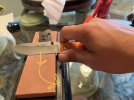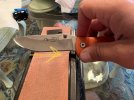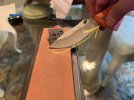- Joined
- Sep 1, 2020
- Messages
- 2,305
So left sketch or right sketch (please dont laugh at my handy work)
Good video, but he isn't addressing how effective the edge is during a forward, cutting motion. He is measuring the cut on a 90 degree, static cut...no foward motion involved That was the reason for my thread.This is a great video I use this on my single bevel blades
Agree.I believe when you get down to the polishing level of sharpening it makes little difference on direction. Don't get me wrong, I see what you are stating and I want the sharpest edge I can obtain but anything past shaving is just bonus or "splitting hairs".
Ha, a "new method" is definitely not the point of the thread...no how, no way.This thread title is blatantly misleading.
I’m expecting some new method, not necessarily one I’m wanting to try, however possibly entertaining at the very least, but nope.
Oh I’m totally into sharp broadheads and am now interested in the topic of the angle of the grooves…but I was just trying to make a butt joke…Ha, a "new method" is definitely not the point of the thread...no how, no way.
This is about a basic concept that a lot of hunters don't realize, not about some new and great way to get er done.
How many guys don't really know what a sharp broadhead is?
We find wounded game via blood trails and there is a proven increase in bleeding (and less clotting) relative to the sharpness of the broadhead. "Sharp" is relative and subjective. The the point of this thread is only about one aspect of one detail of improving the technique of sharpening a broadhead.
It's amazing how so many little unimportant details (unimportant in the minds of some hunters) can be vital towards a successful hunt.
Little details...
How many don't really understand wind?
Or deer's body language?
Odor reduction?
And 99 other details?
Every successful hunt comes down to either pure luck, or attention to little details, or a combination of each. Some things we can control and some we cannot. Control what we can.
I hunt with Grizzlystik Samurai heads and they advertise them as sharp of the package. Yeah, they ain't too bad as a starting point, and a lot of hunters will accept that factory edge, I used to think they were sharp out of the box. But they aren't as good as they can be. I can make mine better with one level of honing, but even at that, they aren't as sharp as ones honed while paying attention to a few details that don't take any extra effort to do correctly. It just takes awareness of the proper procedure. A tiny nick, in an artery can make the difference in us fining the critter, or losing it to the coyotes.
Sharp heads...as sharp as you can make them.
Ha, I missed your point. Sorry.Oh I’m totally into sharp broadheads and am now interested in the topic of the angle of the grooves…but I was just trying to make a butt joke…
Sorry to disappoint you.It seems it would be difficult to quantify what you’re saying and the difference it actually makes. I’ll concede it does sound in the weeds and not something I fool with or will fool with.
I miss the days when allegheny tom used so many of his replies hyping up the Treehopper recon saddle that the mods thought he was a vendor or donating milkweed across the continental US for a good causeGood times.
I think you may have misunderstood me about how I finish. That referred to doing the rubber band test for sharpness. Stretch a band with your fingers and then drag a broadhead over it. A sharp broadhead will cut the band and a dull one won't cut it. My point was that my heads cut the band better when pushed in a forward direction than when drawn back in a reverse direction. Admittedly, the difference is almost negligible but there is a difference. Directional sharpening takes no extra effort and if, someday, somehow that fraction of a difference helps to better cut an artery on a marginal hit, it just might help me recover an animal.I get it. In my younger years we chased blue marlin all over the Atlantic. Everything had to be perfect. Hooks had to be honed to a pyramid point and always sharpened away from the point. I've struggled with the method of a strop though... why do you finish with running a blade backwards? I was taught and learned from trail and error mostly, to remove material away from the edge.

 Got a minor burr, knocked it off and with a little gust of effort it passed the paper test. Probably sharp enough to repackage and sell new but not as impressively sharp as my broadheads, and I need my field dressing knives to be seriously sharp. Used to work in many kitchens and nothing is more frustrating (or dangerous) than dull cutting tools. Anyway, I put it in the sheath and went to bed. Went hunting this morning and didn’t see anything so I came back to the sharpener. I couldn’t be satisfied with any effort being made to cut through paper, then I remembered this thread and tried what I believe to be Tom’s suggestion. I rested the blade on the 21 degree guide again, but this time I kept contact and pulled the edge from tail to tip (the direction I usually cut) maybe a dozen times on each side, and got a respectable burr almost immediately.
Got a minor burr, knocked it off and with a little gust of effort it passed the paper test. Probably sharp enough to repackage and sell new but not as impressively sharp as my broadheads, and I need my field dressing knives to be seriously sharp. Used to work in many kitchens and nothing is more frustrating (or dangerous) than dull cutting tools. Anyway, I put it in the sheath and went to bed. Went hunting this morning and didn’t see anything so I came back to the sharpener. I couldn’t be satisfied with any effort being made to cut through paper, then I remembered this thread and tried what I believe to be Tom’s suggestion. I rested the blade on the 21 degree guide again, but this time I kept contact and pulled the edge from tail to tip (the direction I usually cut) maybe a dozen times on each side, and got a respectable burr almost immediately.

Maybe I should edit the title to "Calling all FUSSY broadhead sharpeners"! LOLNot sure what an anal broadhead is but I’m scared
It's used to make Texas heart shots...Not sure what an anal broadhead is but I’m scared
so AT did this post make sense to you?
